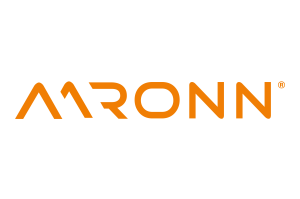Wireless Sensor Networks
Checklist for Mioty-able Sensors
The LPWAN wireless technology mioty offers scalability (massive IoT) and unprecedented reliability. Enough potential to take on a leading role in the field of IIoT wireless technologies in the future. But what steps does a sensor manufacturer have to take to be able to use mioty for its products?
The starting point for the development of the software based LPWAN protocol mioty at the Fraunhofer Institute for Integrated Circuits (IIS) was the goal of overcoming the limitations that still exist in wireless communication in the broad field of industrial IoT applications and setting new standards in terms of scalability, reliability, mobility, efficiency, and flexibility. The key element of the technical implementation is the Telegram Splitting Multiple Access (TSMA) method (Image 1). According to the definition of the European Telecommunications Standards Institute (ETSI TS 103 357), the data packets to be transmitted are divided into smaller sub-packets on the terminal side. The transmission takes place at defined times on different frequencies [1, 2].
By using several algorithms in the mioty base station, it is possible to reconstruct the complete data packet using the received sub-packets. Unlike other LPWAN protocols, which are significantly more susceptible to interference during telegram transmission, mioty offers a much higher robustness due to its unique telegram splitting method and the use of different algorithms. Ideally, a mioty base station needs to receive only 50% of the sent data packet correctly to be able to reconstruct the complete data. The mioty protocol reduces the Packet Error Rate (PER) many times over. Especially in times of massively increasing wireless data transfer due to advancing digitization and the associated growing number of interferences, this technology with its very high reliability offers a decisive advantage.
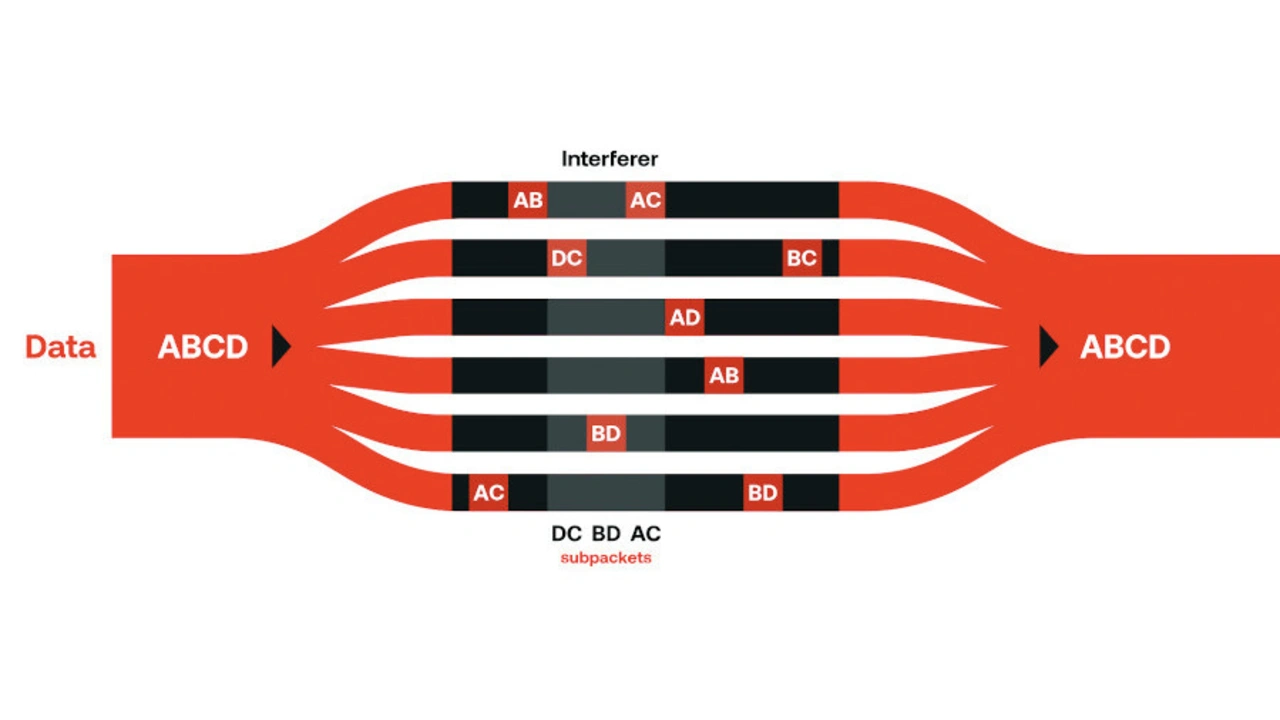
However, mioty is not only characterized by an exceptionally high level of reliability. With a very efficient use of energy, battery lifetimes of up to 20 years can be achieved. In addition, the very stable data transmission of around one million transmitters and up to 1.5 million messages per day can be ensured with just one receiver of a base station, in stationary or mobile operation at speeds of up to 120 km/h. Hundreds of thousands of sensors can thus be operated relatively maintenance-free and energy-efficiently over many years. A further advantage is the possibility of bidirectional communication, if it is supported by the circuit used.
One objective – various architectures
All this sounds like a flexible and, above all, future-oriented wireless protocol for sensor manufacturers. But what exactly needs to be considered when a mioty sensor is to be developed and sold? In order to equip a sensor with mioty capability, it is important to pay attention to the details depending on the application.
For example, if the sensor application is used on the same microcontroller as the communication software (Image 2), it should be noted that the resources of the microcontroller and its periphery must also be shared among each other. This may be a disadvantage for very time-critical sensor applications.
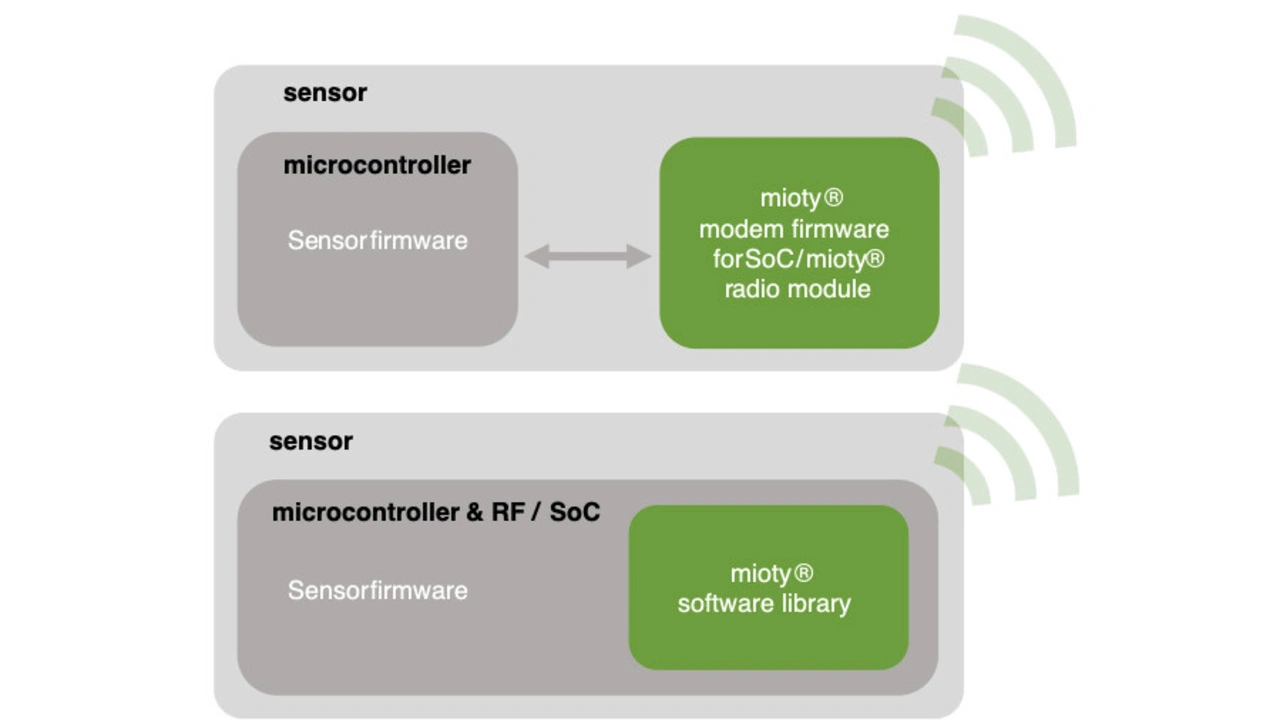
Particular attention should also be paid to the type of communication. With mioty, bidirectional as well as unidirectional communication is possible, but developers should take into account that not all mioty-compatible radio modules currently available on the market support both communication variants.
Let’s first clarify the question which architecture is the right one for connecting the mioty technology for the planned circuit. For sensor manufacturers, there are basically three options:
-
Communication module
In order to equip one's own circuit for sensor evaluation with a mioty radio interface, a mioty communication module can be selected, which takes over the communication with the mioty network (Image 2 above and Image 3).
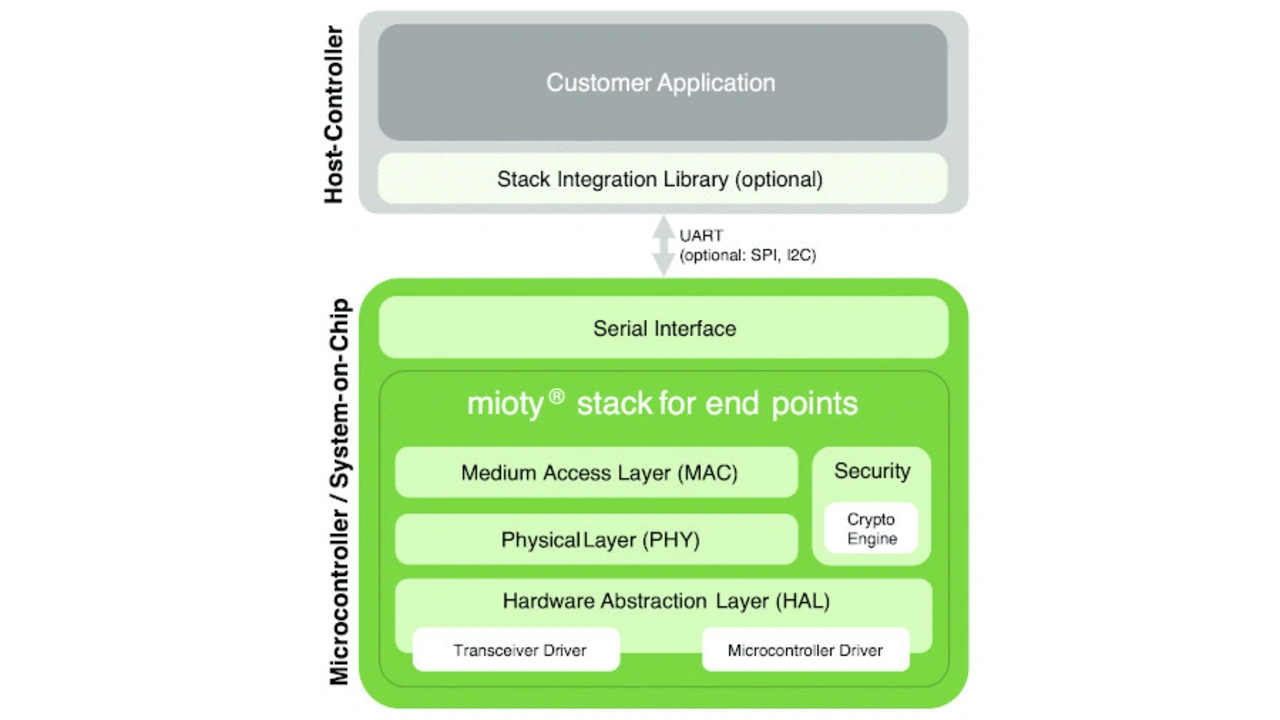
This also makes it possible to equip an existing sensor circuit with a mioty radio interface without major modifications if there is sufficient space available in the enclosure. The mioty communication module is then connected to the sensor circuit via various interfaces, such as UART or SPI. If the communication module is selected, there are three options:
- Use of a pre-programmed mioty radio module,
- Licensing of the mioty protocol stack as firmware in the modem version and
- Licensing the mioty protocol stack as a software library and developing custom firmware for the radio module. The main advantage of this approach is the low development effort and the low risk of surprises when the device is certified.
-
Two-chip approach
An alternative to the communication module is the integration of a dedicated microcontroller together with a radio transceiver IC or a system-on-chip, which is used specifically for communication. In terms of architecture, the two-chip approach is the same as the communication module, but this variant is more space- and cost-saving.
On the software side, the two-chip approach is equally simple compared to using one communication module. However, the effort regarding the circuit is somewhat higher since a corresponding circuit board must be developed and thus the effort for product certification also increases.
-
One-chip approach
The most integrated approach is the use of a mioty-compliant circuit on which the sensor application can be run. This variant requires only one module for the application and the communication software (Image 2, below). A software library (Image 4) will be integrated into the own sensor firmware.
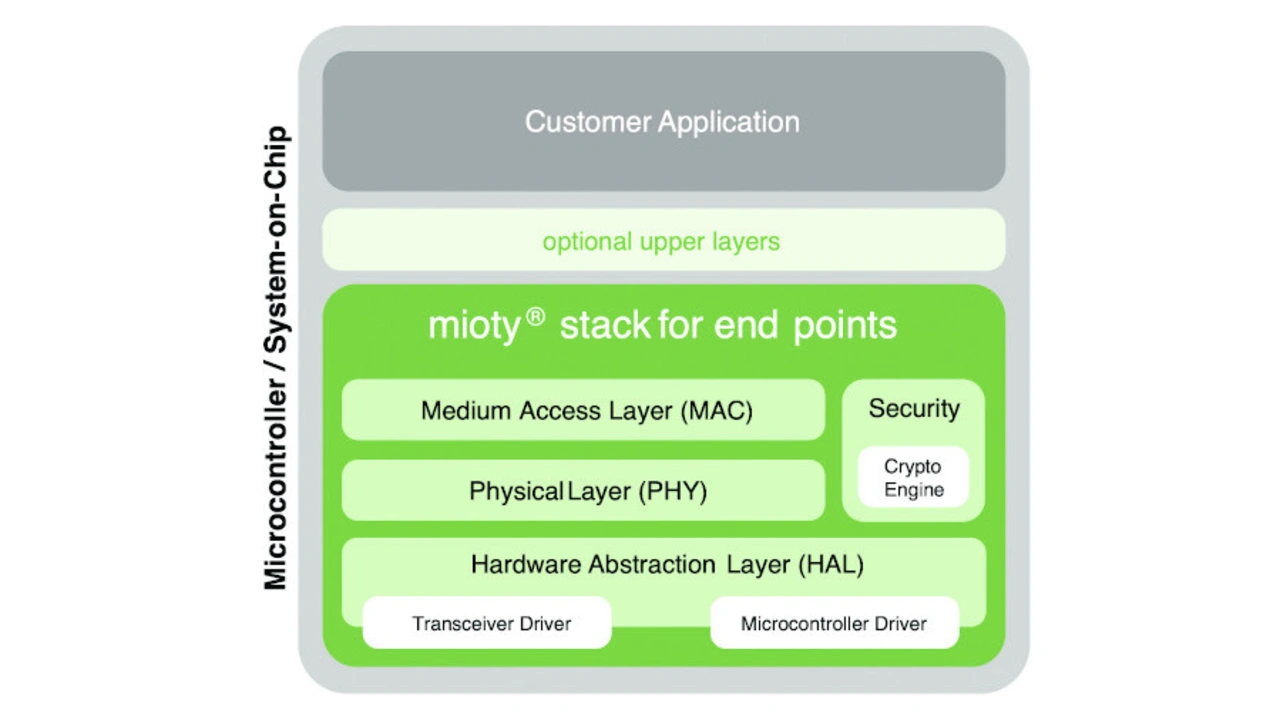
With this library, the developer uses a complete implementation of the transmission protocol and controls the wireless transceiver IC or the wireless transceiver on the radio part of a system-on-chip. The advantage of this approach is obviously the savings in hardware costs as well as in the minimal space requirement of the various options. However, the one-off costs for the development of this approach are significantly higher as a separate and often product-specific hardware design has to be developed.
Likewise, there are a few things to keep in mind when integrating the software library for the mioty protocol stack, since the sensor application and protocol stack share microcontroller resources. In some circumstances, the application uses the computing time that is required by the protocol stack to be able to communicate in a standard-compliant manner. This can typically be verified by appropriate test tools and in any case by the software library vendor.
All in all, this architecture is particularly interesting for high-volume products, which above all require the lowest possible costs per device.
Suitable ICs
Additionally to various microcontrollers in combination with wireless ICs, mioty also supports system-on-chip (SoC) solutions where both the wireless circuit and the microcontroller are integrated in one chip. The main advantage of the SoC components is the small size and the more energy-efficient use of the radio part.
Regarding the hardware, it is a special advantage that mioty is a software-based communication technology. As a result, a large number of wireless ICs available on the market can already be used for mioty. A small selection shows the table.
| radio chip manufacturer | radio chip types |
bidirectional |
|---|---|---|
| Semtech | SX1276 | no |
| STMicroelectronics | S2-LP | no |
| Texas Instruments | CC13x0 | yes |
| Texas Instruments | CC13x2 | yes |
| Silicon Labs | Si4463 | no |
| Silicon Labs | EFR32FG14 | yes |
Table. Selection of some radio ICs that developers can use for Mioty radio sensors. (Source: Stackforce)
Communication software: in-house or purchase?
Clearly, sensor firmware is typically developed by the sensor manufacturer or a software service provider. After all, the firmware with the know-how of the manufacturer is the core of the sensor. But is it therefore advisable for a sensor manufacturer to also implement the communication interfaces in-house? A plus is, of course, that the sensor manufacturer has its own source code. At the same time, however, the maintenance effort of the source code must also be mentioned as a clear disadvantage.
Even if the implementation of a protocol should be completely error-free and efficient in terms of energy requirements, the protocol stack must be edited by the next update of the communication standard at the latest. Therefore, there are a number of aspects for leaving the implementation of the protocol stack to a specialist – maintenance and warranty are just two of them.
Obtaining a protocol stack is very simple, there are typically two licensing models:
- One-off: In this model a one-time fee is paid. In return, the licensee receives the protocol stack as a software library or as firmware and can use it in any number of products, i. e. copy it as often as desired. Due to its simple handling, it is usually the preferred licensing model, but commercially it is mainly suitable for products that are produced in large quantities.
- Post-paid royalties: Typically, this option initially incurs an upfront fee. Once the fee has been paid, the protocol stack can be used in products. The license agreement also contains a passage that obliges the sensor manufacturer (licensee) to report the number of products produced and equipped with the protocol stack after an agreed interval. Based on these reports low staggered unit license fees are payable.
This licensing model is particularly interesting if the quantities are not very high or it is not yet clear how much the quantities will be and whether a one-off license would be useful. This type of license may later be replaced by a one-off license if the number of units is significantly higher than originally expected. Please note that the licenses for the software implementation do not include the necessary rights to use the patents, as explained in the next chapter.
License models
For the use and sale of a mioty-capable sensor licenses of the patented technology are required. This also applies to mioty base stations. The licensing fees for both the software and the technology differ between the unidirectional and the bidirectional variant. As a sensor manufacturer, this should be considered at an early stage, as the licensing fees for the communication software differ for example also for the relevant patents. The patent pool, which includes all patents relevant to mioty, is managed by the IP management company Sisvel International, headquartered in Luxembourg.
Obtaining a mioty technology license is very simple:
- First, a license agreement is signed.
- Thereafter, regular reporting on the number of units produced will be provided in accordance with the agreement.
- Based on this reporting, a small fee is paid per device. Sisvel also offers discount options, for example, by announcing the desired number of unit licenses in advance.
Full details and up-to-date information on this are available on Sisvel's website. In any case, it is advisable to contact Sisvel International even in case of minor uncertainties to ensure a smooth licensing process.
Hands-on
A very easy start is possible for example with a CC1312 LaunchPad from Texas Instruments and a modem firmware from Stackforce. This provides a developer with an independent mioty communication module that can be controlled via a serial interface (e. g. USB). The actual sensor application can be developed on a second, arbitrary system. For initial testing or development, a Command Line Interface (CLI) program from Stackforce can be used to operate the communication module with the CC1312 microcontroller directly from a PC.
Mioty base station
A mioty base station is required as the remote station of the mioty end nodes. This can be obtained from different manufacturers. There are already several variants available: Diehl's premium base station is closest to the reference design from Fraunhofer IIS, but currently only supports the »small« EU profiles EU0 and EU1. Another premium base station is available from the Canadian company Behrtech. It is geared to the American market and therefore primarily supports the US profile US0, but also the »large« EU profile EU2. The Ava gateway from Weptech can also be interesting as a low-cost variant for entry and initial tests. It is less powerful than the premium base stations in terms of radio characteristics and therefore cannot demonstrate the full potential of mioty, but it is available for just a few hundred euros.
The base stations typically provide a web interface that can be used to configure the network and get an overview of the mioty data traffic.
Literature
[1] Sikora, Dr. A.: Funkprotokoll für Massive IoT – Standard für skalierbare Netzwerke. elektronik.de, 17.9.2020, https://www.elektroniknet.de/kommunikation/wireless/standard-fuer-skalierbare-netzwerke.178949.html.
[2] Bernhard, J.; Dünkler, R.; Kneißl J. und Otte, L.: Funknetzwerke – Mioty – die Revolution des IoT. elektronik.de, 18.4.2019, https://www.elektroniknet.de/kommunikation/wireless/mioty-die-revolution-des-iot.164612.html.
[3] Mioty Massive, secure and powerful LPWAN technology, About MIOTY Licensing Platform. Sisvel International, Website, www.sisvel.com/licensing-programs/wireless-communications/mioty/introduction.
[4] Mioty Stack. Stackforce, Website, www.stackforce.de/mioty-stack.
The author

Patrick Weber
graduated from Offenburg University of Applied Sciences with a degree in Electrical Engineering/Information Technology (B. Eng.) and in Computer Science (M. Sc.). After graduating, he initially worked in the development department at MSC Technologies before moving to Stackforce as a development engineer.
Meanwhile, as a Principal Engineer at Stackforce, he is mainly responsible for project management and software architecture, but also involved in the development of various protocol stacks. He also leads the Application Layer Task Force, a task force of the Mioty Alliance Technical Committee.
patrick.weber@stackforce.de







